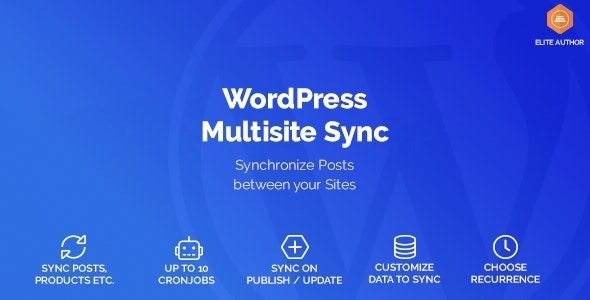WordPress Multisite Sync 1.1.13

70+ Reviews
with 5 star Ratings

99% Customer
Satisfaction

7-Days
Money Back
Request update for this product.
$99.00 Original price was: $99.00.$2.99Current price is: $2.99.
- Version: 1.1.13
- Last Updated: 29/09/2024
- License: GPL
- 1 year of updates & unlimited domain usage
- Updates Will Come With A 24-48h Delay
- Original product with the lowest price ever
- Downloaded from original authors
- Instant delivery & fast downloading speed
- 100% clean and tested code
- Get this Product for Free in Membership
WordPress is one of the most popular content management systems (CMS) globally, powering over 40% of all websites. Its flexibility, scalability, and vast ecosystem of plugins make it a go-to platform for businesses, developers, and individuals alike. One of the more advanced features of WordPress is Multisite, a setup that allows you to run multiple websites from a single WordPress installation. For organizations managing several websites, keeping content and data in sync across these sites can be a challenge. This is where WordPress Multisite Sync comes into play.
In this article, we’ll delve into what WordPress Multisite Sync is, its benefits, how it works, and the best practices for setting it up, all while optimizing for SEO to ensure your website ranks better in search engines.
What is WordPress Multisite Sync?
WordPress Multisite Sync refers to the process of synchronizing data, content, or media between different sites in a WordPress Multisite network. In a typical WordPress Multisite setup, you may have multiple sites under the same WordPress installation. For instance, you could have different subdomains or subdirectories like example.com, site1.example.com, and site2.example.com.
While this structure makes management easier, it can become cumbersome to manually copy content, plugins, or settings between the sites. Multisite Sync helps automate this process, ensuring that updates on one site are reflected across others. This is particularly useful for businesses or organizations that manage several localized websites or different departments requiring similar updates.
Benefits of WordPress Multisite Sync
- Centralized Management The most significant advantage of WordPress Multisite Sync is that it allows for centralized management of content across multiple sites. Whether you are updating blog posts, pages, or products in an eCommerce network, the sync feature makes it easier to distribute these changes efficiently.
- Consistency Across Sites When you have several websites running under the same umbrella, maintaining consistency in content, branding, and design becomes essential. Multisite Sync ensures that your sites remain uniform, reducing errors and inconsistencies.
- Reduced Manual Effort Instead of manually updating each site with the same content, plugin, or theme, Multisite Sync automates the process. This saves time, minimizes errors, and reduces the workload for site administrators.
- SEO Advantages Keeping consistent content across your multisite network can improve your SEO performance. Search engines prefer cohesive, well-organized websites with clear content structures. WordPress Multisite Sync ensures that your SEO strategy is aligned across all websites, making it easier to rank higher on search engine results pages (SERPs).
- Plugin and Theme Updates When using Multisite Sync, you can easily update themes or plugins across your network of websites without needing to log in to each one individually. This is particularly beneficial for security patches and feature updates, ensuring that your network remains up-to-date.
How Does WordPress Multisite Sync Work?
WordPress Multisite Sync typically works by allowing the synchronization of content, media, settings, or even entire databases across a network of WordPress sites. Depending on your specific needs, synchronization can happen in real-time or be scheduled at intervals. Here are some key aspects of how it operates:
1. Content Synchronization
Content synchronization involves syncing posts, pages, custom post types, and even taxonomies (such as categories and tags) across multiple sites in the network. For example, if you publish a new blog post on the main site, it can automatically appear on all or selected sites within the network.
2. Media Synchronization
This involves syncing media files such as images, videos, or PDFs. This is particularly useful for organizations running multiple localized sites that require the same images for marketing purposes. Instead of uploading the same media to each site, a central repository can serve all sites.
3. User Data Synchronization
For organizations with multisite setups that have a single login or user base across multiple sites, syncing user data is essential. Multisite Sync can keep user roles, permissions, and account details consistent across the network, allowing for a seamless user experience.
4. Plugin and Theme Synchronization
Plugins and themes form the backbone of WordPress customizations. In a Multisite network, it’s crucial to ensure that plugins and themes are consistent and up-to-date across all sites. Multisite Sync can automate this process, making sure that when a plugin or theme is updated on one site, it is updated across the entire network.
5. Database Synchronization
More advanced forms of Multisite Sync involve syncing database entries, such as settings or configurations, between sites. This can ensure that changes to core site settings are reflected across the network.
Best Practices for Setting Up WordPress Multisite Sync
Setting up a Multisite Sync can be a complex task depending on the size of your network and the type of content or data you need to sync. Below are some best practices to ensure a smooth and efficient process:
1. Choose the Right Plugins
There are several WordPress plugins available that help manage Multisite Sync. Some of the popular ones include:
- Multisite Content Copier: This plugin allows you to easily copy posts, pages, and media across sites in your network.
- Broadcast: A robust plugin that synchronizes content across sites with advanced features for handling different content types.
- WP Ultimo: Primarily used for creating SaaS (Software as a Service) networks, but also has features for syncing data between sites.
It’s crucial to choose plugins that meet your specific needs, whether it’s content, media, or database synchronization.
2. Plan Your Sync Strategy
Not all data may need to be synchronized across all sites. Plan which content, media, or settings should be shared and which should remain unique to specific sites. For instance, a global company may want to sync certain pages, like the “About Us” or “Contact” pages, but leave localized content unique to each region.
3. Test Before Deployment
Before rolling out synchronization across your entire network, thoroughly test it on a staging environment. This will help you catch potential errors and ensure that everything works as expected before it goes live.
4. Monitor Sync Performance
Once the sync is set up, monitor its performance. Ensure that updates happen as scheduled, and there are no lags or failures in the process. Using a plugin that offers detailed logs or notifications about sync status can help with this.
5. Backup Regularly
Anytime you are dealing with syncing multiple websites, the risk of data loss or corruption increases. Regular backups of your entire network are essential. In case of any issues, you can easily restore previous versions of your sites.
Challenges of WordPress Multisite Sync
While WordPress Multisite Sync offers a range of benefits, there are some challenges and potential pitfalls to be aware of:
- Complex Setup: Depending on the size and complexity of your network, setting up synchronization can be a challenging process, especially if database synchronization is involved.
- Increased Server Load: Syncing large amounts of data between sites can put a strain on your server resources, leading to slower load times or even downtime.
- Potential for Conflicts: Syncing plugins, themes, or content can sometimes lead to conflicts if different sites have custom modifications or configurations.
Conclusion
WordPress Multisite Sync is a powerful feature that simplifies the management of multiple websites under a single WordPress installation. It ensures consistency across sites, reduces manual effort, and improves efficiency. When set up correctly, it can enhance your site’s SEO performance by maintaining uniformity and improving content delivery.
You must be logged in to post a review.




Reviews
Clear filtersThere are no reviews yet.